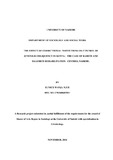| dc.description.abstract | The main objective of this study was to investigate and establish the response of correctional
institutions on control of juvenile delinquency in Kenya. It has been observed that
Rehabilitation centers are meant to make effective rehabilitation function, but there is a
challenge of increased juvenile Delinquency.
The study has five specific objectives which include: to establish the Magnitude of juvenile
Delinquency, to underscore the importance of committing juveniles delinquents to the
correctional institutions, to examine the methods used in correctional institutions to minimize
delinquency, to find out if the resources in the correctional institutions responsible to juvenile
delinquent are adequate to carry out their mandate, and establish the effect of correctional
institution to curb juvenile delinquency. The research questions were derived from these
specific objectives.
The study adopted Descriptive survey research design, using a cross-sectional survey design
from cohort of respondents. The target population of the study was the institutional staff and
the juveniles who had been committed in the institution for two years and above. Systematic
sampling was used to select a sample of 100 juveniles using their list as a sampling frame.
Sample size of staff members was 6 members. The questionnaire, focus group and interview
guide was used to collect data. The questionnaire and focus group discussion guide was used to
the juveniles. The interview guide was used to interview the key informants.
The data was coded and grouped according to the objectives of the study. The major findings
are that, study indicated that the juveniles were admitted in the rehabilitation where they were
taken through a process of rehabilitation, which include: counselling, formal education,
vocational training, fashion and design, life skill training, spiritual welfare and Agriculture.
Vocational training was found more necessary to address their anti-social behaviour. It
equipped them with skills that would provide them with job opportunity. Vocational training
included: masonry. Carpentry and joinery, Agriculture, Tailoring and Dress making, Bakery
and Electrical all were skill training programmes.
The findings indicated that the institutions are responding in a way that is helping to control
juvenile delinquency in Kenya in spite of inadequate teaching staff and stationeries,
The study recommended that the government should recruit enough staff in the institutions to
enable control of juvenile delinquency. Vocational training being the most important course to
the juveniles that equip them with skills to get employment should be given more focus. All
lessons should be taught to both boys and girls because the society today has no gender role.
Effort should be made to provide enough stationeries, classrooms and dormitories to the
juveniles. Beddings should be improved.
Severe punishment should not be given to the children because it is inflicting the children’s
rights. All the institutions that the researcher visited children were caned severely and punished
by sending them in the institution farm during class time.
The institutions were well managed, rules and regulations were followed that assisted in
guiding the juveniles in everyday life. Hair and dressing to be taught at the Institution
especially for the girls. None of the institution was taught saloon issues yet the juveniles liked
it. | en_US |

